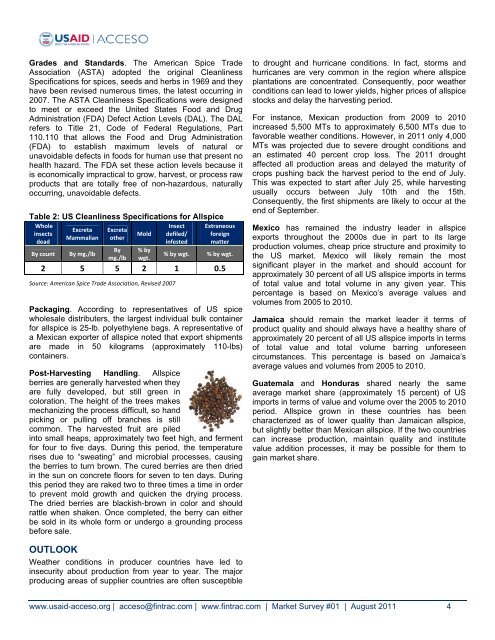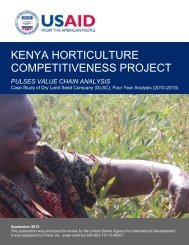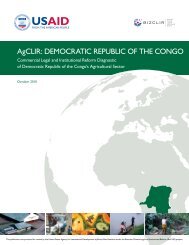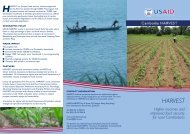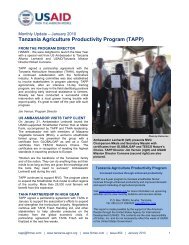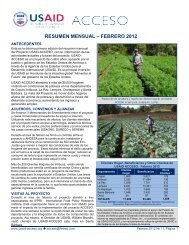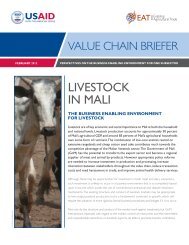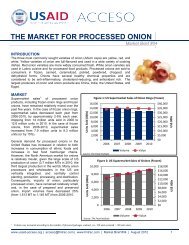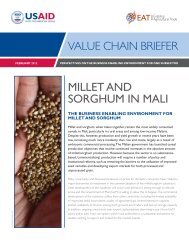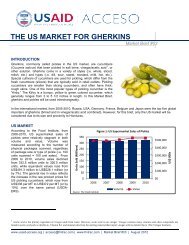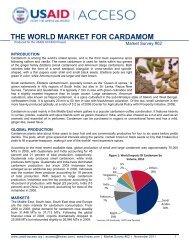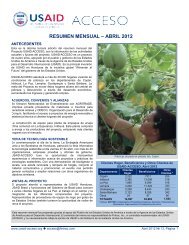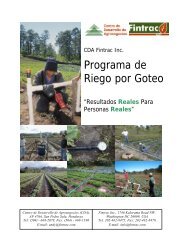THE MARKET FOR ALLSPICE - Fintrac Inc.
THE MARKET FOR ALLSPICE - Fintrac Inc.
THE MARKET FOR ALLSPICE - Fintrac Inc.
Create successful ePaper yourself
Turn your PDF publications into a flip-book with our unique Google optimized e-Paper software.
Grades and Standards. The American Spice Trade<br />
Association (ASTA) adopted the original Cleanliness<br />
Specifications for spices, seeds and herbs in 1969 and they<br />
have been revised numerous times, the latest occurring in<br />
2007. The ASTA Cleanliness Specifications were designed<br />
to meet or exceed the United States Food and Drug<br />
Administration (FDA) Defect Action Levels (DAL). The DAL<br />
refers to Title 21, Code of Federal Regulations, Part<br />
110.110 that allows the Food and Drug Administration<br />
(FDA) to establish maximum levels of natural or<br />
unavoidable defects in foods for human use that present no<br />
health hazard. The FDA set these action levels because it<br />
is economically impractical to grow, harvest, or process raw<br />
products that are totally free of non-hazardous, naturally<br />
occurring, unavoidable defects.<br />
Table 2: US Cleanliness Specifications for Allspice<br />
Whole<br />
insects<br />
dead<br />
Excreta<br />
Mammalian<br />
By count By mg./lb<br />
Excreta<br />
other<br />
By<br />
mg./lb<br />
Mold<br />
% by<br />
wgt.<br />
Insect<br />
defiled/<br />
infested<br />
Extraneous<br />
foreign<br />
matter<br />
% by wgt. % by wgt.<br />
2 5 5 2 1 0.5<br />
Source: American Spice Trade Association, Revised 2007<br />
Packaging. According to representatives of US spice<br />
wholesale distributers, the largest individual bulk container<br />
for allspice is 25-lb. polyethylene bags. A representative of<br />
a Mexican exporter of allspice noted that export shipments<br />
are made in 50 kilograms (approximately 110-lbs)<br />
containers.<br />
Post-Harvesting Handling. Allspice<br />
berries are generally harvested when they<br />
are fully developed, but still green in<br />
coloration. The height of the trees makes<br />
mechanizing the process difficult, so hand<br />
picking or pulling off branches is still<br />
common. The harvested fruit are piled<br />
into small heaps, approximately two feet high, and ferment<br />
for four to five days. During this period, the temperature<br />
rises due to “sweating” and microbial processes, causing<br />
the berries to turn brown. The cured berries are then dried<br />
in the sun on concrete floors for seven to ten days. During<br />
this period they are raked two to three times a time in order<br />
to prevent mold growth and quicken the drying process.<br />
The dried berries are blackish-brown in color and should<br />
rattle when shaken. Once completed, the berry can either<br />
be sold in its whole form or undergo a grounding process<br />
before sale.<br />
OUTLOOK<br />
Weather conditions in producer countries have led to<br />
insecurity about production from year to year. The major<br />
producing areas of supplier countries are often susceptible<br />
to drought and hurricane conditions. In fact, storms and<br />
hurricanes are very common in the region where allspice<br />
plantations are concentrated. Consequently, poor weather<br />
conditions can lead to lower yields, higher prices of allspice<br />
stocks and delay the harvesting period.<br />
For instance, Mexican production from 2009 to 2010<br />
increased 5,500 MTs to approximately 6,500 MTs due to<br />
favorable weather conditions. However, in 2011 only 4,000<br />
MTs was projected due to severe drought conditions and<br />
an estimated 40 percent crop loss. The 2011 drought<br />
affected all production areas and delayed the maturity of<br />
crops pushing back the harvest period to the end of July.<br />
This was expected to start after July 25, while harvesting<br />
usually occurs between July 10th and the 15th.<br />
Consequently, the first shipments are likely to occur at the<br />
end of September.<br />
Mexico has remained the industry leader in allspice<br />
exports throughout the 2000s due in part to its large<br />
production volumes, cheap price structure and proximity to<br />
the US market. Mexico will likely remain the most<br />
significant player in the market and should account for<br />
approximately 30 percent of all US allspice imports in terms<br />
of total value and total volume in any given year. This<br />
percentage is based on Mexico’s average values and<br />
volumes from 2005 to 2010.<br />
Jamaica should remain the market leader it terms of<br />
product quality and should always have a healthy share of<br />
approximately 20 percent of all US allspice imports in terms<br />
of total value and total volume barring unforeseen<br />
circumstances. This percentage is based on Jamaica’s<br />
average values and volumes from 2005 to 2010.<br />
Guatemala and Honduras shared nearly the same<br />
average market share (approximately 15 percent) of US<br />
imports in terms of value and volume over the 2005 to 2010<br />
period. Allspice grown in these countries has been<br />
characterized as of lower quality than Jamaican allspice,<br />
but slightly better than Mexican allspice. If the two countries<br />
can increase production, maintain quality and institute<br />
value addition processes, it may be possible for them to<br />
gain market share.<br />
www.usaid-acceso.org | acceso@fintrac.com | www.fintrac.com | Market Survey #01 | August 2011 4


